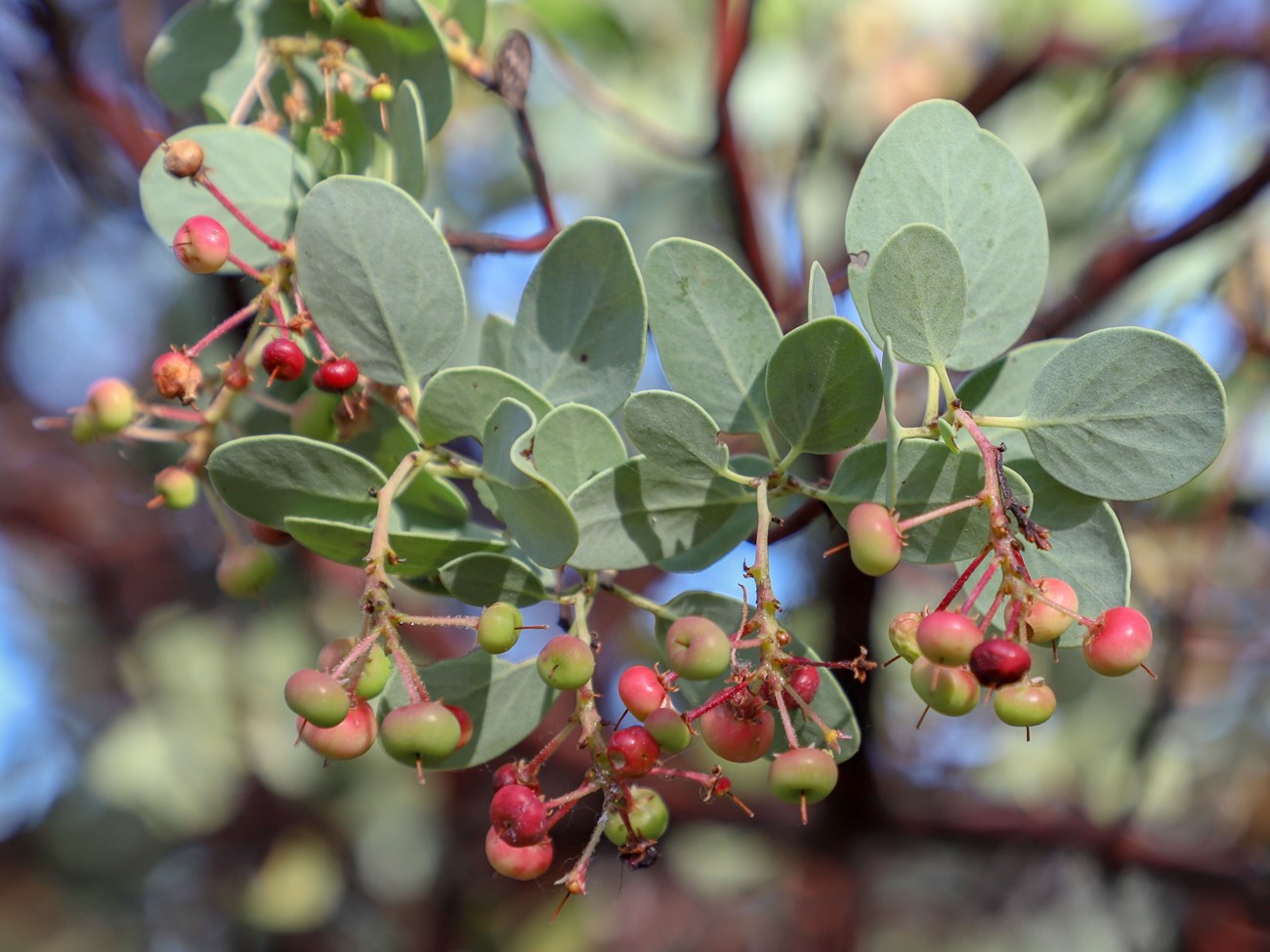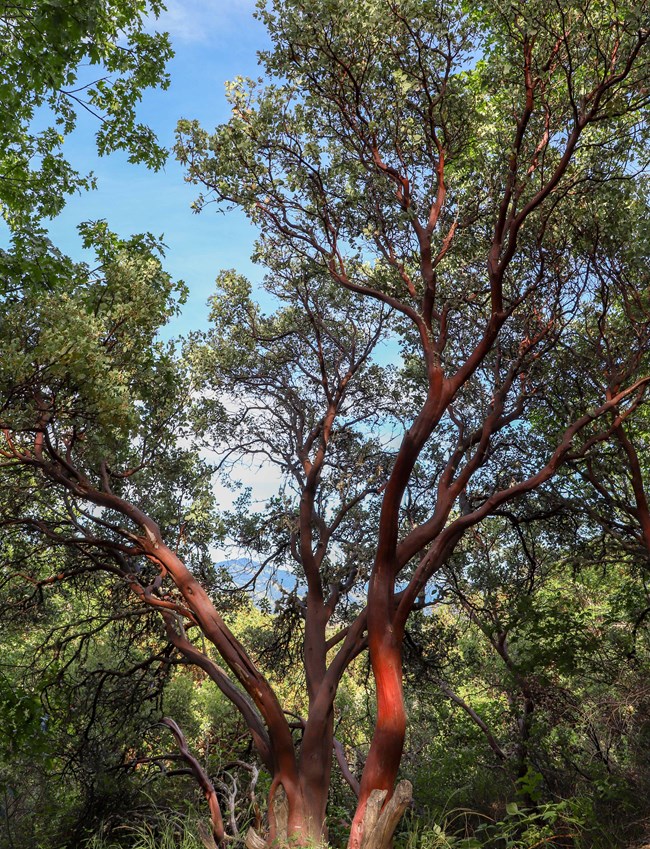Last updated: February 22, 2022
Article
Whiteleaf Manzanita

Leia Althauser
General Description
Where whiteleaf manzanita (Arctostaphylos viscida) grows, one may often find a twisting canopy of gnarled branches covered in smooth, dark reddish-brown bark. On some branches ribbons of dead bark hold a host of lichens while other branches’ bark peels away to reveal spots of bright orange, green or yellow.Also known as sticky whiteleaf manzanita, the plant is an evergreen shrub in the heath family (Ericaceae). Its leathery, ovate, silver colored leaves will tilt on edge during the heat of a summer’s day, reducing overheating and water loss. In the spring, it will grow an abundance of small, pinkish-white, urn shaped flowers. Its fruits are small, red brown berries. The shrub grows in varying shapes and sizes depending on which ecosystem it lives in, but it is typically 1 to 4 m (3 to 13 ft) tall and found at elevations ranging from 30 to 2,200 m (100 to 7,200 ft).
Habitat and Distribution
Whiteleaf manzanita occupies valley floors and hills of chaparral, oak-woodland and mixed conifer ecosystems from central California up through southwest Oregon. It grows at low elevations in Mediterranean climates (hot, dry summers and mild, wet winters). It is shade intolerant and commonly occupies dry, sunny slopes with rocky soils, preferably in open areas. In chaparral it grows in pure stands or with other shrubs like Ceanothus, as well as scattered oak trees. It also occurs in chaparral that has recently experienced crown fire—a fire where the foliage is completely consumed—as well as logged, bulldozed or other sites that have experienced mechanical disturbance.Ecology
Some researchers call whiteleaf manzanita a “fire-dependent” or “fire recruiter” species meaning that the plant relies on fire and may even encourage fires in order to reproduce. The plant’s seeds have a hard coating that makes them both fire resistant and fire dependent. Typically the seed covering protects the encapsulated embryo seed from fire, which allows seeds in the soil to survive. When fire comes through, it scarifies (makes small lacerations in) the hard seed coat, which ends dormancy and allows for germination.While the seeds may be resistant to fire, even low-intensity fires kill adult whiteleaf manzanita. The waxes and oils on the leaves and in the branches produce high-energy, readily heated fuel that aids in ignition. Whiteleaf manzanita has a low-moisture content, particularly so after a summer drought. During summer droughts, some branches may die. The plant sheds bark continually and loses its evergreen leaves when they are old. The combination of flammable foliage, leaf litter, oils, and low-moisture wood creates a perfect amalgamation of fuel for a fire. Shrubs may literally burst into flames that are several times the height of the shrubs. Some researchers find it interesting that when a fire kills adult populations, the same event triggers the simultaneous start of a new population of the species.
Flammability may have evolutionary advantages for whiteleaf manzanita. Its large, dormant seedbank requires fire to germinate, and the flammable characteristics of adult plants allow the species to regenerate itself in large populations in post-fire areas. Whiteleaf manzanita can enhance its establishment by promoting the spread and intensity of fire, which reduces competition from other species. The result is a patchy mosaic on the landscape that may increase diversity.

Leia Althauser
Food and Habitat for Wildlife
While the leaves of whiteleaf manzanita are unpalatable and provide little nutrition, the berries are an important source of food for a variety of wildlife, such as the American black bear (Ursus americanus), coyotes (Canis latrans), mule deer (Odocoileus hemionus), brush rabbit (Sylvilagus bachmani), dusky-footed woodrat (Neotoma fuscipes), sooty grouse (Dendragapus fuliginosus) and more. The dense, interlocking stands that whiteleaf manzanita forms provide cover and nesting sites for a variety of small mammals and birds. The plant is also host to a variety of moth and butterfly species, such as the brown elfin (Callophrys augustinus), ceanothus silkmoth (Hyalophora euryalus) and the western sheepmoth (Hemileuca eglanterina).
Fun Facts
-
Native American tribes such as the Maidu, Miwok and Wintu would use the flowers and fruit of the manzanita to make cider. They would also make jelly from the fruits and use the tannins in the leaves to tan leather.
-
Manzanita means “little apple” and the name describes the tiny, apple-like fruit.
Conservation
Whiteleaf manzanita is not a listed species of concern.
Where to See
Whiteleaf manzanita can be found at Whiskeytown National Recreation Area, Redwoods National and State Parks and Oregon Caves National Monument.
More Information
https://calscape.org/plantleps.php?species=Arctostaphylos+viscida
https://plants.usda.gov/plantguide/pdf/cs_arvi4.pdf
Download a pdf of this article.
Prepared by Leia Althauser, Southern Oregon University science communication intern
NPS Klamath Inventory & Monitoring Network
Southern Oregon University
1250 Siskiyou Blvd
Ashland, OR 97520
Featured Creature Edition: July 2019
